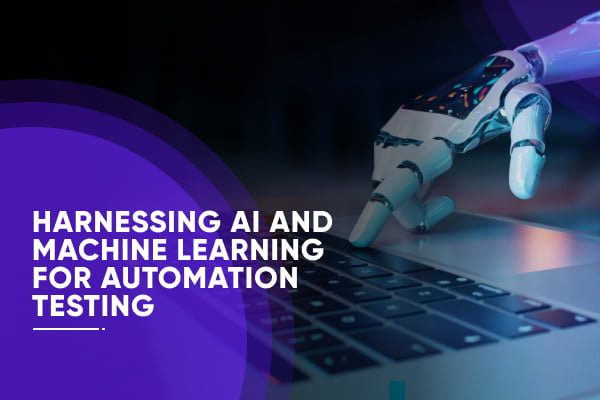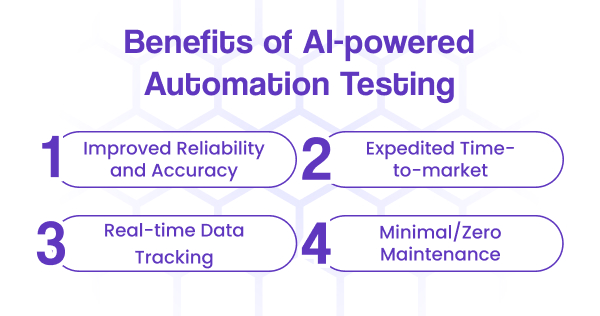As we enter the age of smart technologies, automated testing has become an indispensable part of modern software development. As the demand for quick and reliable testing grows, integrating AI tools into creating test scripts is becoming a standard practice.

Creating efficient test scripts requires a thorough comprehension of the application’s design, a strategic approach to tackle different test scenarios, and the ability to modify scripts to adjust to changes in the application. Traditional methods often involve a significant amount of manual work, which can introduce errors and cause delays in the testing process. This is where using AI and related tools revolutionizes the testing landscape.
This article explores the significance of AI and ML for automated testing and how it can transform the way testing is executed across various frameworks.
Role of AI in Software Testing
The role of AI in software testing has skyrocketed since the pandemic. Valued at $736.8 million in 2023, the AI-enabled testing market is expected to grow at a whopping CAGR of 20.7% by the end of 2030.
On top of offering some basic enhancements to the testing processes, – improved accuracy, automation of repetitive tasks, enhanced efficiency, etc. – AI-powered tools provide some advanced features to escalate the way testing is executed:
- Natural Language Processing (NLP): In the coming years, NLP will emerge as a crucial trend that will revolutionize software testing by enabling efficient analysis and automation. AI systems can comprehend and generate test cases, bug reports, and documentation in natural language. This improves communication between machines and humans, reduces manual effort, and enhances test coverage and quality assurance.
- Deep Learning: Deep Learning and Neural Networks explore AI advancements transforming automation testing. AI systems improve accuracy and efficiency by identifying, analyzing, and predicting software anomalies, reducing manual testing efforts. The integration of AI in software testing speeds up development and ensures high quality in software products that adapt to evolving digital landscapes.
- Predictive Analytics: ML and predictive analytics help in identifying bugs and performance issues more efficiently and accurately. Advanced algorithms analyze vast amounts of data and learn from past test cases to predict potential problem areas in new software. This approach reduces manual testing efforts and time-to-market, allowing for continuous integration and deployment, while customizing test scenarios based on historical data to enhance the precision of test results. We can expect to see this trend being mastered and heavily utilized in the current year and beyond.
Benefits of AI-powered Automation Testing

- Improved Reliability and Accuracy: AI-driven tests offer consistency in every test cycle. While manually testing applications, human error plays a major role in the success/failure of test scripts. AI-powered test automation scripts reduce this risk manyfold, leading to higher accuracy and reliability in test execution.
- Expedited Time-to-market: AI-powered test automation further reduces the time taken to test applications and systems. Intelligent technologies are popular for their ability to analyze big datasets and identify bugs and other anomalies quickly. The added capabilities of AI/ML to continuously learn help improve the test cases further and offer comprehensive test coverage.
- Real-time Data Tracking: The ability of AI tools to monitor real-time data enables teams to recognize issues in software as and when they happen. Smart technologies can also recognize which component possibly caused the error, eliminating the need to test the whole system over and over. This reduces the time spent on manual monitoring while improving UX through quick problem resolutions.
- Minimal/Zero Maintenance: By implementing AI-driven test automation, you are unleashing the potential of self-healing tests. The technology used in this process considers all the element IDs, enabling the test to self-correct if any data point changes. It is important to note that the test can distinguish between intentional data alterations and a malfunctioning test. What does this mean? Your testing teams spend minimal effort in maintaining the test scripts and AI-driven tools do the majority of maintenance work.
Trends Shaping the AI-powered Test Automation Industry
- Self-Healing Capabilities of Test Scripts: One of the ways AI is used in test automation is to create self-healing test scripts, which help QA teams improve their effectiveness. Whenever there is a change in the user interface, multiple test automation scripts need to be updated. If an AI-powered test fails after an update, AI software testing tools can automatically update the script. This is because AI can better differentiate between a ‘change’ and a ‘bug’ than human-led manual testing processes.
- Explainable AI: In the near future, explainable AI will become an important factor in utilizing AI tools that provide clear and understandable test results. This will enable testers to build trust and reliability in the automated testing process. As a result, businesses will prioritize the use of explainable AI models for greater transparency and trustworthiness in decision-making processes. The primary objective of this shift is to comply with evolving regulatory standards and meet customer demands for more comprehensible AI-driven outcomes.
- AI Spidering: Automated testing utilizing machine learning is becoming increasingly popular recently. One of the most common practices is “spidering,” where AI testing applications automatically crawl through an application. As these tools crawl through the application, they collect data by taking screenshots, downloading the HTML address, and measuring load times. By repeating these steps, patterns and defects can be identified and fixed quickly.
- Codeless Automation: As we progress into the intelligent-technologies age, democratizing QA is becoming an increasingly crucial trend, all thanks to the availability of codeless automation tools. These innovative solutions allow experts with varying levels of coding expertise to participate in test automation, providing diverse perspectives and ultimately contributing to the development of more robust and user-centric product quality.
- Exploratory Testing: Exploratory Testing has traditionally been considered a non-automatable task. However, some organizations have started training testing bots with self-learning capabilities to observe a QA engineer manually exploring a web application to identify defects. These bots gradually learn from their observations, crawl the application, and identify unusual patterns in future runs. While Exploratory testing requires human intelligence, AI can significantly speed up the process.
Challenges of Incorporating AI/ML in Test Automation
While AI/ML can automate most of the testing processes, smart technologies can only take your QA efforts so far. The amalgamation of these new-age technologies with QA cycles is a trend on the precipice of dawn. It might be some time before we can perfect this blend of desirable inputs. Until then, here are some common roadblocks that organizations might encounter while shifting to AI-based test automation:
- Dynamic Machine Learning Models: With every innovation in smart technologies, new features reach the market. This is a continuous process making it difficult for testers to incorporate such changes frequently into the test scripts. This is one of the major challenges encountered while leveraging AI/ML for test automation.
- The ‘Black Box’ Gap: There may be gaps in the understanding of testers due to the complex decision-making of AI-based models. QA teams might find it hard to decode the reason behind receiving certain outputs. Developing strategies that focus on understanding the decision-making algorithms of the model rather than input-output verifications, can help teams overcome this challenge.
- Compliance with Regulatory Frameworks: A rising concern for AI/ML-powered tools lies with abiding by the regulatory frameworks and complying with ethical and legal concerns.
Conclusion
To conclude, AI is not just a passing trend or buzzword. AI-based tools add an array of benefits to your test automation cycles, including improved test coverage, accuracy, and risk mitigation. Furthermore, by incorporating AI-driven testing tools, you can optimize your software development processes and enhance the quality of your products. However, relying heavily on smart technologies without human interference might not offer the results organizations desire due to the bottlenecks we briefly discussed above. To leverage the full potential of AI-driven automation, the ideal blend lies somewhere between a strategic amalgamation of intelligent automation with traditional testing capabilities.
About the Author
Yogesh Patni is a seasoned marketing manager at ImpactQA and navigating the dynamic landscapes. With a solid educational background and several years of hands-on experience, Yogesh has become an integral part of one of the leading testing companies. At ImpactQA, we provide a wide range of testing services including test automation, cloud-based load testing, security testing, functional testing, performance testing, and many more.


Keep up the great work! Thank you so much for sharing a great posts.